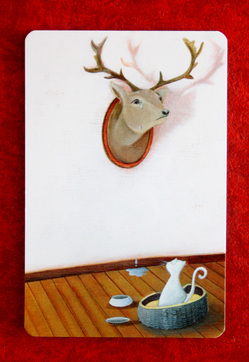Dix-it is a game where 4-6 players are dealt hands of cards that feature dream like or surreal images. From there each player takes turns being the “storyteller” who says a statement or a phrase to describe a card in their hand. The other players then select cards from their hand that might fit this statement and everyone puts their cards in the center. From there, the non-storytellers vote on which card they think was the storyteller’s and the storyteller gets no points if no one correctly guesses their card or if everyone guesses their card and the storyteller gets points if some, but not everyone guesses their card. The non-storytellers get points if they deceive other players into guessing their card as well as points for guessing the correct card with more points if not everyone guessed the correct card. While the players are playing they move little bunny pieces representing each player on a small board that keeps track of the points. The player who wins is the first person to reach the end of the board.
The first thing that stood out to me was the artwork. There is just some uncanny valley weirdness to much of the art featured in the cards and as someone who really loved weird and sort of kitschy art I loved looking at the cards. The art has a hand-drawn or painted quality to it with the textures and shadows and there is a simplicity to many of the figures or scenes paired with bright colors that makes me think of art you would see in a children’s storybook. I find this art style very fitting considering the game’s emphasis on imagination and “story-telling.” Outside of this, the odd nature of many of the images works to enhance the core gameplay as many of the images are vague enough that they could be applied to a whole host of phrases or words players can come up with. For example, a card featuring a man made out of autumn leaves walking on a path has so much to it, is the man leaving a place, is he going somewhere, why is he made out of leaves, what is he going to do and more that someone could come up with many stories for just one card.


The main gameplay of guessing was something I actually found rather enjoyable. There is some similarity to games such as charades and Pictionary where the other players are trying to guess or understand what one player meant with their actions, in Dix-it’s case with their words. I felt that the point system Dix-it has really enhanced the quality of the guessing gameplay and created an interesting spin to the genre of guessing games. While oftentimes in guessing games people earn points for simply guessing what the person is trying to portray properly, Dix-it’s point system punishes players who make their statements too obvious. This creates an interesting situation where the storyteller will have to try to thread the line between obvious enough for someone to get it, but niche enough that not everyone will instantly know which card is yours. You don’t want to be too vague because you do not gain points if no one guesses your card, but you also do not want to be too obvious because you don’t get points if everyone guesses your card. I think this provides a unique twist to a typical guessing game that makes interesting strategies arise. I played with my game group who I had only known for about a week at that point, but I can see how if you play with people you know there can be an advantage given to players who share inside jokes or knowledge with each other that might actually make the game feel sort of unfun for players who are out of the loop. For us there were some interesting strategies that arose some players tried saying dates out as their phrase in hopes that someone would know the date and one particularly interesting time a player referenced something I had said in the earlier round for their phrase as a way to ensure that I could get it while the others might not have picked up on the reference.
Overall, I would say Dix-it was an enjoyable experience as I liked the more social party game feeling although I think some aspects of the game could have been more interesting such as the “board-game” aspect of the game as the board was effectively only a points keeper. It might have been compelling for there to be more of a story or extra mechanic with the board, however, that is moreso just a nit-pick. I think Dix-it succeeds at being a game that requires a bit of strategy and a whole lot of imagination.
